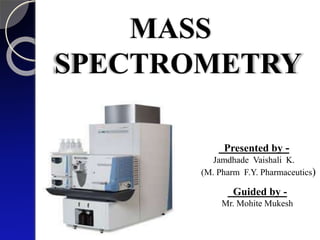
Mass spectrometry
- 1. MASS SPECTROMETRY Presented by - Jamdhade Vaishali K. (M. Pharm F.Y. Pharmaceutics) Guided by - Mr. Mohite Mukesh
- 2. Introduction Basic principle Fragmentation Types of ions Fragmentation processes CONTENT 1
- 3. Mass spectrometry (MS) is an analytical technique in which sample is converted to rapidly moving positive ions i.e. cations by electron bombardment and separate the ions on the basis of their Mass to charge ratio. INTRODUCTION In simple terms mass spectrum measures the masses within the sample. 2
- 4. In mass spectrometer parent ions are formed by removal of electron as follows: M(g) + e M+(g) + 2e The m/e value of the parent ion is equal to the molecular mass of the compound. The mass spectrometer is designed to perform 3 basic functions. These are: i. To vapourise compounds. ii. To produce ions from the neutral compounds in the vapour phase. iii. To separate ions according to their mass to charge ratio. 3
- 5. MASS SPECTRUM OF BROMINE 4
- 6. What is Mass Number…? The Mass Number (A), also called as atomic mass number is the total number of protons (Z) and neutrons (N) in atomic nucleus. Mass Number (A) No. of Neutrons (N) + No. of Protons (Z) 5
- 7. 6
- 8. PRINCIPLE Organic molecule are bombarded with electron Converted into highly energetic cations (Molecular ion or Parents ions) Further break up into smaller ions (Fragment ion or daughter ions) The formed ions are separated into deflection in magnetic field according to mass to charge ratio Mass spectrum 7
- 9. 8
- 10. FRAGMENTATION Bombardment of molecules by an electron beam with energy between 10-15eV usually results in the ionization of molecules by removal of one electron (Molecular ion formation). When the energy of electron beam is increased between 50-70ev, these molecular ions acquire a high excitation resulting in their break down into various fragments. This process is called “ Fragmentation process”. 10
- 11. 11
- 12. 12 Fragment ions / Daughter ions. TYPES OF IONS Molecular ions / Parent ion.
- 13. 1. When a molecule is bombarded with electrons in high vacuum in Mass spectrometer, it is converted into positive ions by loss of an electron. These ions are called as Molecular or Parent ions. M + e M+° + 2e— Where, M – represents the Molecule; M+°– represents the Molecular or Parent ion MOLECULAR IONS / PARENT IONS 2. The order of energy required to remove electron is as follows— electrons > non-conjugated > conjugated > non bonding or lone pair of electrons. 13
- 15. FRAGMENT IONS / DAUGHTER ION • An electrically charged dissociation product of an ionic fragmentation. Such an ion may dissociate further to produce other electrically charged molecular or atomic moieties of successively lower formula weight. • This ions are formed from breakdown of molecular ions in to smaller ions. • Also called as Daughter ion. • Examples of common fragment ions are as follows: 15
- 16. Sr. No Ions m/e 1 CH3 15 2 O 16 3 OH 17 4 Cl 35,37 5 NO2 46 6 CN 26 7 C6H5 77 16
- 17. TYPES OF PEAKS IN MS 1. Molecular peak 2. Fragment peak 3. Rearrangement ion peak 4. Base peak 5. Metastable ion peak 6. Multicharged ions
- 18. Molecular Peak When the sample is bombarded with electron of 9 to 15 eV energy, the molecular ions are produced molecular ion, by loss of single electron. Fragment ion Peak When energy more than 70 eV are applied, then fragment ion are produced. They have lower mass number. Rearrangement ion Peak Recombination of fragment ion is known as rearrangement peaks. Multiple charged Peak This ion may have 2-3 charge instead of single charge 18
- 19. 1. α - cleavage 2. Sigma bond cleavage 3. Inductive cleavage 4. McLafferty rearrangement 5. Retro-Diels-Alder reaction TYPES OF FRAGMENTATION 19
- 20. 20 Alpha fragmentation in MS is characteristic fragmentation of molecular ion derived from Carbonyl compound , in which the bond linking the carbonyl carbon to atom shows alpha bond breaks. It is expected pathway for following functional groups - Ether Alcohol Halide Amines Carbonyl compound α - Cleavage
- 22. Sigma Bond Cleavage The ionization of alkanes weakens the C-C bond, ultimately resulting in the decomposition. As bond breaks, A charged, even electron species (R+) and a neutral radical species (R•) are generated. Highly substituted carbocations are more stable than the nonsubstituted ones. 21
- 23. Inductive Cleavage This reaction results from the inductive effect of the radical sites. This reaction is defined as a Heterolytic Cleavage since a pair of electrons is transferred. The driving forces for such reaction are the electronegativities of the radical sites: halogens > O, S >> N, C. This reaction is less favored than radical-site reactions. 22
- 24. McLafferty Rearrangement This involves migration of gamma- hydrogen atom followed by the cleavage of β-bond. Elimination of neutral molecules from aldehydes, ketone, amine, unsaturated compounds, substituted aromatic compound etc takes place. The rearrangement proceeds through a sterically hindered 6 membered transation state. 23
- 25. 24 This rearrangement can occur in :- Ketone Aldehyde Carboxylic acid Ester
- 26. Butanal contaions a gamma-hydrogen atom. The McLafferty rearrangement ions formed in this case is shown below- 25 Example – Butanal
- 27. Retro-Diels -Alder Rearrangement • This reaction occurs mainly in Cyclohexene and its derivatives. • In this first ionization occur and electrons from double bond transfers to the adjacent carbon and the electron from the bond between the 3-4 carbon atom transfer to from a double bond that is conjugate with the first one. • This rearrangement cleave the molecule between 3 and 4, and 5 and 6 carbon atom. • This rearrangement produces olefin and a diene. 26
- 28. 28
- 29. THANK YOU